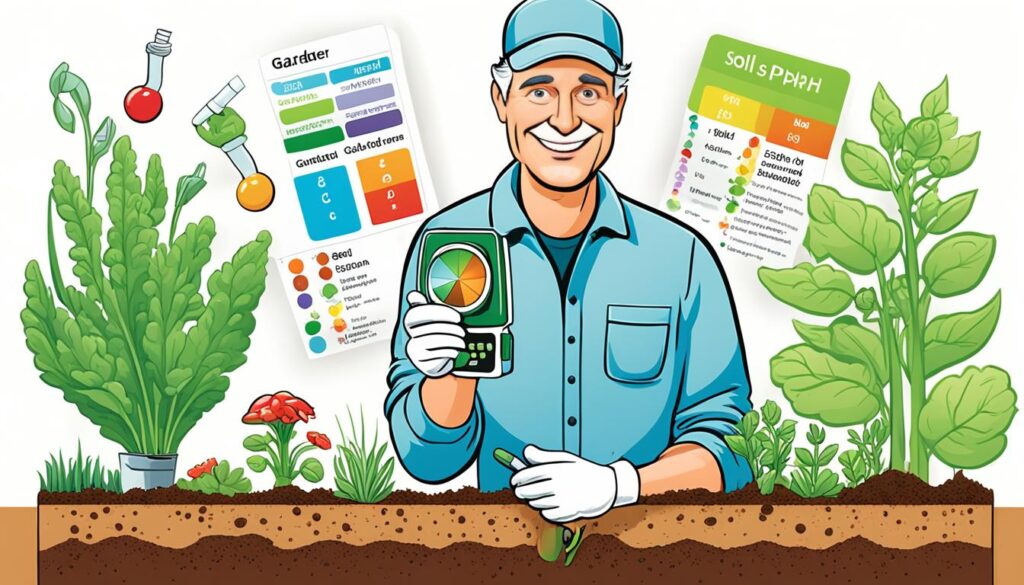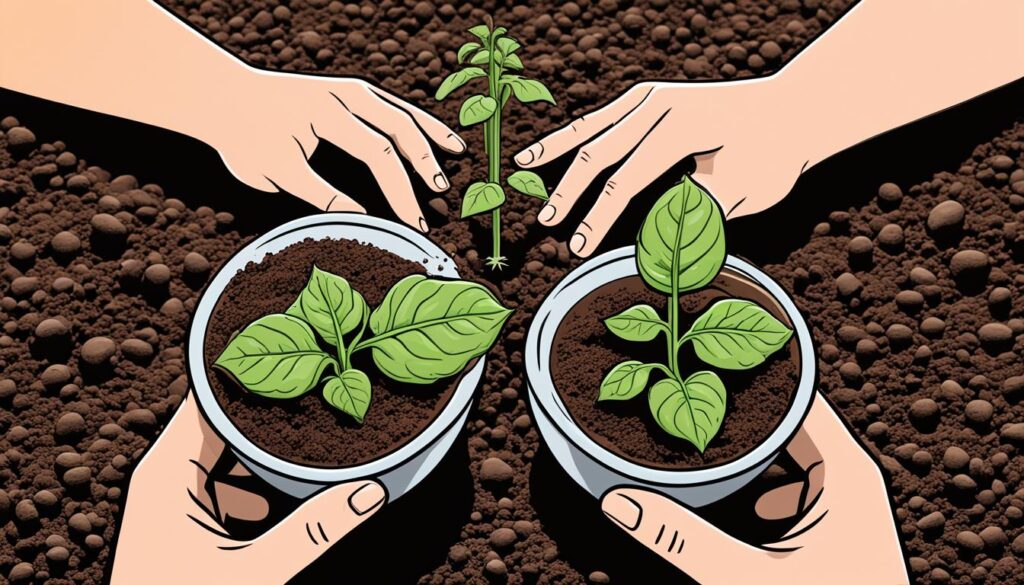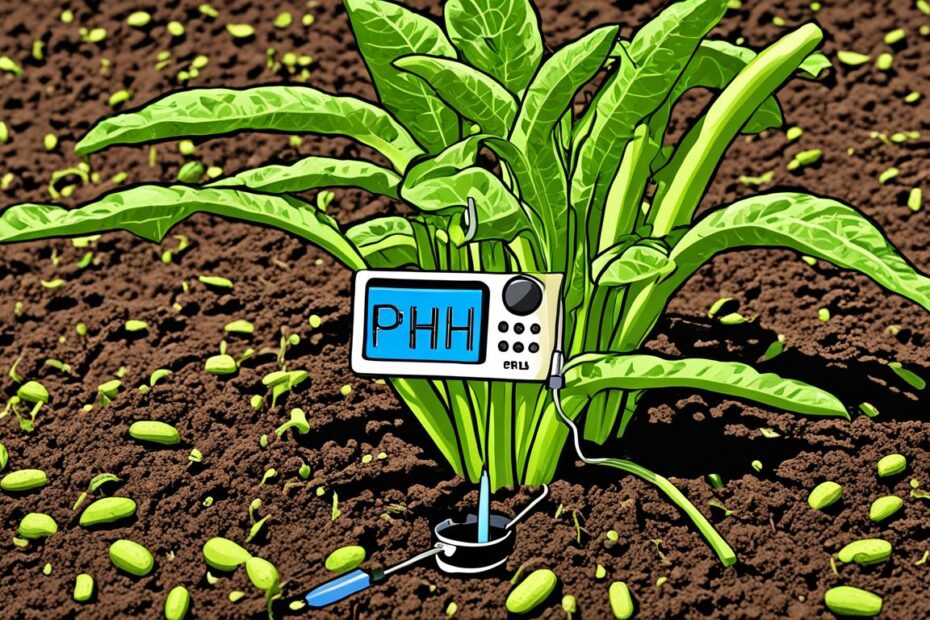Have you ever wondered why some zucchini plants flourish while others struggle to produce even a single fruit?
The secret may lie in the soil pH of your zucchini garden. Soil pH, the measurement of soil acidity or alkalinity, plays a crucial role in the plant’s ability to absorb essential nutrients. By understanding the ideal soil pH for zucchini and ensuring your soil has the correct pH level, you can unlock the full potential of your zucchini garden and enjoy a bountiful harvest. But what exactly is soil pH and how does it affect your zucchini plants? Let’s dig deeper to find out.
Key Takeaways:
- Soil pH is a crucial factor in the success of your zucchini garden.
- Understanding the ideal soil pH for zucchini is essential for nutrient absorption.
- Testing and adjusting soil pH will ensure optimal growing conditions for zucchini.
- Improving soil structure and fertility is vital for the health of your zucchini plants.
- Maintaining the appropriate soil pH throughout the growing season is key to a bountiful harvest.
The Role of Soil pH in Plant Nutrition
Soil pH plays a vital role in the nutrition of plants, including zucchini. With a pH range of 6.0 to 6.5, slightly acidic soil provides the optimal conditions for most plants to thrive, including zucchini. When the soil pH deviates from this range, it can affect the availability of nutrients to the plants.
In this pH range, essential nutrients like nitrogen, phosphorus, and potassium are readily available for uptake by the zucchini plants, promoting healthy growth and ensuring bountiful harvests. However, when the soil pH is too acidic or alkaline, certain nutrients may become less available or may be excessively present, leading to nutrient imbalances.
Imagine soil pH as a key that unlocks the door to nutrient availability for your zucchini plants. By achieving the optimal soil pH, you are providing the plants with the best possible environment to access and absorb the essential nutrients they need for vigorous growth.
The Relationship Between Soil pH and Nutrient Availability
Let’s take a closer look at how soil pH impacts nutrient availability:
| Nutrient | Optimal Availability pH Range | Effects of Deviations from Optimal Range |
|---|---|---|
| Nitrogen (N) | 5.5 – 7.0 | Below the range: Nitrogen deficiency, stunted growth. Above the range: Excess nitrogen, reduced fruiting. |
| Phosphorus (P) | 6.0 – 7.0 | Below the range: Phosphorus deficiency, delayed maturity. Above the range: Reduced uptake of other nutrients. |
| Potassium (K) | 5.0 – 7.0 | Below the range: Potassium deficiency, weakened stems. Above the range: Magnesium and calcium imbalances. |
As you can see from the table above, maintaining the optimal soil pH helps ensure that these crucial nutrients are available to your zucchini plants in the right amounts at the right time, promoting their health and productivity.
Testing and Adjusting Soil pH
Testing your soil pH is a crucial step in ensuring that it is suitable for growing zucchini. The pH level of the soil directly affects the availability of nutrients to your plants, including zucchini. By testing your soil’s pH, you can determine if it falls within the ideal range for zucchini cultivation.
There are two common methods for testing soil pH:
- Soil test kits: These kits are readily available and provide a simple, at-home method for testing soil pH. Follow the instructions provided with the kit to collect soil samples and measure the pH level.
- Professional soil testing services: For a more comprehensive analysis, you can send soil samples to a professional testing laboratory. They will provide you with detailed soil test results, including pH levels and nutrient recommendations.
Once you have determined your soil’s pH level, you can make adjustments as needed to create the optimal growing conditions for zucchini. Depending on your soil’s pH, you may need to raise or lower it to achieve the ideal range.
If your soil pH is too acidic (below the ideal range), you can adjust it by adding agricultural lime. Agricultural lime helps raise the pH of acidic soil, making it more neutral. Follow the recommended application rates provided by the manufacturer or consult a local gardening expert for guidance.
If your soil pH is too alkaline (above the ideal range), you can lower it by adding elemental sulfur. Elemental sulfur works by gradually decreasing the pH of alkaline soil over time. Again, refer to the recommended application rates and consider seeking advice if needed.
It’s important to note that adjusting soil pH is an ongoing process. After making adjustments, retest your soil’s pH periodically to ensure it remains within the desired range for zucchini growth.

Testing and adjusting soil pH is a critical part of creating the optimal environment for your zucchini garden. By testing your soil and making necessary adjustments, you can establish the ideal pH level to support healthy plant growth and maximize your zucchini harvest.
Improving Soil Structure and Fertility
To achieve optimal growth for your zucchini, it is essential to focus not only on adjusting soil pH but also on improving soil structure and fertility. By enhancing the soil’s composition, drainage, and nutrient-holding capacity, you can create the perfect environment for your zucchini plants to thrive.
One effective way to improve soil structure and fertility is by adding organic matter to your garden. Incorporating compost or well-rotted manure into the soil can work wonders. Organic matter acts as a natural conditioner, promoting better soil texture and structure, allowing air and water to circulate easily.
In addition to improving soil structure, organic matter contributes to the overall health of the soil ecosystem. It supports the growth of beneficial microorganisms that play a vital role in breaking down organic matter and releasing essential nutrients for your zucchini plants.
“Incorporating organic matter into your soil can bring life back to tired soils and create a lush, flourishing garden.”
Boosting soil fertility is another crucial aspect of zucchini cultivation. When your soil is nutrient-rich, it provides the necessary elements for robust plant growth and development.
Here’s a table highlighting the benefits of improving soil structure and fertility in your zucchini garden:
| Benefits of Improving Soil Structure and Fertility |
|---|
| Enhanced water retention |
| Improved nutrient availability |
| Increased root development |
| Promotion of beneficial soil microorganisms |
| Better nutrient absorption by plants |
To achieve these benefits, ensure you add organic matter to your soil before planting your zucchini. Mix it thoroughly, incorporating it into the top layers of the soil for maximum effectiveness.
Remember, by focusing on soil structure and fertility, you can create an optimal growth environment that will result in thriving zucchini plants and a bountiful harvest.
Selecting the Right Soil for Zucchini
When planning your zucchini garden, it is important to consider the soil type and characteristics. Zucchini plants prefer well-drained soils with a sandy loam texture. These soils provide good aeration, moisture retention, and root development. Avoid heavy clay soils, as they can become compacted and waterlogged, leading to poor zucchini growth. If your existing soil does not meet the requirements for zucchini cultivation, consider using raised beds or container gardening with appropriate soil amendments to create the ideal growing environment.
One common mistake that gardeners make is neglecting the importance of proper soil selection for zucchini cultivation. The right soil can make all the difference in the health and productivity of your zucchini plants. Sandy loam soil, which is a mixture of sand, silt, and clay, is considered the ideal soil texture for zucchini. It provides good drainage while retaining enough moisture for the plants. This type of soil also allows for better aeration and root development, which are crucial for healthy zucchini growth.
“Choosing the right soil for zucchini is like laying a solid foundation for a successful garden. It sets the stage for robust growth, bountiful harvests, and thriving plants.”
On the other hand, heavy clay soils can be problematic for zucchini cultivation. Clay soils have smaller particles that can become compacted when wet, restricting root growth and leading to waterlogged conditions. This can cause root rot and other diseases that negatively impact zucchini plants’ health and overall productivity. If you have heavy clay soil in your garden, it’s important to amend it with organic matter, such as compost or well-rotted manure, to improve its structure and drainage capability. Alternatively, consider using raised beds or container gardening using a suitable soil mix specifically formulated for vegetable cultivation.
Soil Selection Tips for Zucchini Cultivation
Here are some tips to help you select the right soil for zucchini cultivation:
- Choose well-drained soils with a sandy loam texture.
- Avoid heavy clay soils that can become compacted and waterlogged.
- Consider using raised beds or container gardening to create a suitable growing environment.
- Amend clay soils with organic matter to improve drainage and structure.
By selecting the right soil for your zucchini garden, you are laying the foundation for successful cultivation. This will provide your zucchini plants with the optimal growing conditions they need to thrive and produce a bountiful harvest.
| Soil Type | Characteristics |
|---|---|
| Well-drained sandy loam soil | Good aeration, moisture retention, and root development |
| Heavy clay soil | Compacted and waterlogged, leading to poor zucchini growth |

Zucchini Garden Care Tips
Nurturing your zucchini garden requires dedicated care and attention. By following these essential zucchini garden care tips, you can ensure that your plants thrive throughout the growing season.
1. Regularly Monitor Soil pH and Make Adjustments
The first step in zucchini garden care is maintaining the appropriate soil pH. Regularly test the soil pH and make necessary adjustments to create optimal conditions for zucchini growth. Keep the pH within the range of 6.0 to 6.5, ensuring that essential nutrients are readily available.
2. Weed-Free Garden for Healthy Zucchini
Weeds not only compete for nutrients but also provide hiding spots for pests. Keep your zucchini garden weed-free by removing any unwanted vegetation. This helps prevent stress on the plants and promotes healthy growth.
3. Pest Control to Protect Your Zucchini Plants
Prevent pest infestations, such as aphids, by implementing effective pest control strategies. Regularly inspect your plants for signs of pest damage and act promptly to protect your zucchini crop. Organic pest control methods, like neem oil or insecticidal soap, can be effective and safe options.
4. Proper Watering and Sunlight for Optimal Growth
Zucchini plants require consistent moisture and adequate sunlight for optimal growth. Water the plants deeply, ensuring the soil is evenly moist but not waterlogged. Provide them with at least 6-8 hours of direct sunlight daily to promote healthy foliage and abundant fruiting.
5. Regular Fertilization for Nutrient Balance
Supply your zucchini plants with balanced nutrients for robust growth and bountiful harvests. Use a slow-release organic fertilizer or compost, following the instructions for application rates. Regularly fertilize throughout the growing season to maintain nutrient balance and support plant health.
| Zucchini Garden Care Tips | Benefits |
|---|---|
| Regularly monitor soil pH | Ensures optimal nutrient availability |
| Keep the garden weed-free | Prevents competition for nutrients and reduces pest hiding spots |
| Implement effective pest control | Protects plants from pests and minimizes damage |
| Provide proper watering and sunlight | Promotes healthy growth and fruiting |
| Regularly fertilize | Sustains nutrient balance for robust plant health |
Implementing these zucchini garden care tips will ensure your plants thrive, producing an abundance of delicious zucchinis. With proper care and attention, your zucchini garden will be a source of pride and bountiful harvests.
Harvesting and Enjoying Your Zucchini
Once your zucchini plants reach maturity, it’s time to enjoy the fruits of your labor. Harvest zucchini when they are young and tender for the best flavor. Regular harvesting promotes continuous production throughout the growing season.
Zucchini can be used in various recipes, from salads to stir-fries and even baked goods. Experiment with different cooking techniques and flavors to fully enjoy the bounty from your zucchini garden.
Here are some popular zucchini recipes to inspire your culinary creations:
- Grilled Zucchini Salad with Feta and Fresh Herbs: This refreshing salad combines grilled zucchini with tangy feta cheese, fresh herbs, and a zesty lemon dressing.
- Zucchini Noodles with Pesto and Cherry Tomatoes: Replace traditional pasta with zucchini noodles for a healthier twist. Toss them with homemade pesto and juicy cherry tomatoes for a delightful summer dish.
- Zucchini and Goat Cheese Stuffed Chicken Breast: Elevate your chicken breast by filling it with a mixture of sautéed zucchini and creamy goat cheese. Bake until golden and serve with a side of roasted vegetables.
- Chocolate Zucchini Bread: Sneak some veggies into your dessert with this moist and chocolatey zucchini bread. It’s the perfect treat to enjoy with a cup of coffee or tea.
Get creative in the kitchen and let your zucchini harvest inspire you to create delicious and nutritious meals. With the right recipes, zucchini can be a versatile ingredient that adds flavor, texture, and vibrancy to any dish.
“Zucchini is a culinary chameleon, ready to adapt to any flavor profile or cooking method. From savory to sweet, there’s a zucchini recipe for every taste bud.”
Zucchini Recipes at a Glance
| Recipe | Description |
|---|---|
| Grilled Zucchini Salad with Feta and Fresh Herbs | A refreshing salad with grilled zucchini, tangy feta cheese, fresh herbs, and a zesty lemon dressing. |
| Zucchini Noodles with Pesto and Cherry Tomatoes | Healthy zucchini noodles tossed with homemade pesto and juicy cherry tomatoes. |
| Zucchini and Goat Cheese Stuffed Chicken Breast | Chicken breast stuffed with sautéed zucchini and creamy goat cheese, baked to perfection. |
| Chocolate Zucchini Bread | Moist and chocolatey bread made with grated zucchini, perfect for a sweet treat. |
Let your imagination run wild and savor the delicious flavors of zucchini in these mouthwatering recipes.
Conclusion
Achieving the optimal soil pH is crucial for unlocking the full potential of your zucchini garden. By understanding the role of soil pH in plant nutrition and following proper care practices, you can create the ideal growing conditions for thriving zucchini plants.
Testing and adjusting the soil pH, as needed, ensures that the necessary nutrients are readily available for uptake by the plants. Adding appropriate amendments to achieve the desired pH level will promote healthy growth and abundant harvests.
Improving soil structure and fertility, along with selecting the right soil type, further enhances zucchini plant growth. With the right soil pH and proper maintenance, you can enjoy a bountiful harvest of delicious zucchini throughout the growing season. Happy gardening!
FAQ
Why is soil pH important for zucchini?
Soil pH is crucial for zucchini because it affects the availability of nutrients to the plant. Zucchini plants thrive in slightly acidic soil with a pH range of 6.0 to 6.5. Maintaining the optimal soil pH ensures that the necessary nutrients are readily available for uptake by the plants, leading to healthy growth and abundant harvests.
How can I test the pH of my soil?
You can test the pH of your soil using soil test kits or by availing professional soil testing services. These methods provide an accurate measurement of your soil’s pH level and help you determine if it is suitable for growing zucchini. If the pH is outside the ideal range, appropriate soil amendments can be added to adjust the pH and create optimal conditions for zucchini growth.
What are the ideal soil conditions for zucchini?
Zucchini plants prefer slightly acidic soils with a pH range of 6.0 to 6.5. They also require well-drained soils with a sandy loam texture, which provide good aeration, moisture retention, and root development. It is important to avoid heavy clay soils that can become compacted and waterlogged, as they hinder proper zucchini growth.
How can I improve the soil structure and fertility for zucchini?
Improving the soil structure and fertility is essential for optimal zucchini growth. Adding organic matter, such as compost or well-rotted manure, helps enhance the soil’s structure, drainage, and nutrient-holding capacity. Organic matter also supports beneficial microorganisms and improves overall soil fertility. Incorporating organic matter into the soil creates the ideal conditions for successful zucchini cultivation.
Can I grow zucchini in containers or raised beds?
Yes, if your existing soil doesn’t meet the requirements for zucchini cultivation, you can opt for container gardening or create raised beds with appropriate soil amendments. This allows you to control the soil conditions and create the ideal growing environment for zucchini plants.
How do I maintain the appropriate soil pH for my zucchini garden?
Regularly monitoring the soil pH and making necessary adjustments is crucial for maintaining the optimal conditions for zucchini growth. If the pH deviates from the ideal range, you can adjust it using appropriate soil amendments such as agricultural lime to raise the pH of acidic soil or elemental sulfur to lower the pH of alkaline soil. Regular testing and adjustments will ensure that the soil pH remains suitable for zucchini plants throughout the growing season.
When should I harvest zucchini?
Zucchini should be harvested when they are young and tender for the best flavor. Regular harvesting promotes continuous production throughout the growing season. Harvest zucchini when they are around 6 to 8 inches long and the skin is still shiny and easily pierced with a fingernail. This ensures that you enjoy the best-tasting zucchini from your garden.
What can I do with harvested zucchini?
Harvested zucchini can be used in various recipes, including salads, stir-fries, and even baked goods. You can experiment with different cooking techniques and flavors to fully enjoy the bounty from your zucchini garden. Let your culinary creativity shine and make the most of your harvested zucchini!
